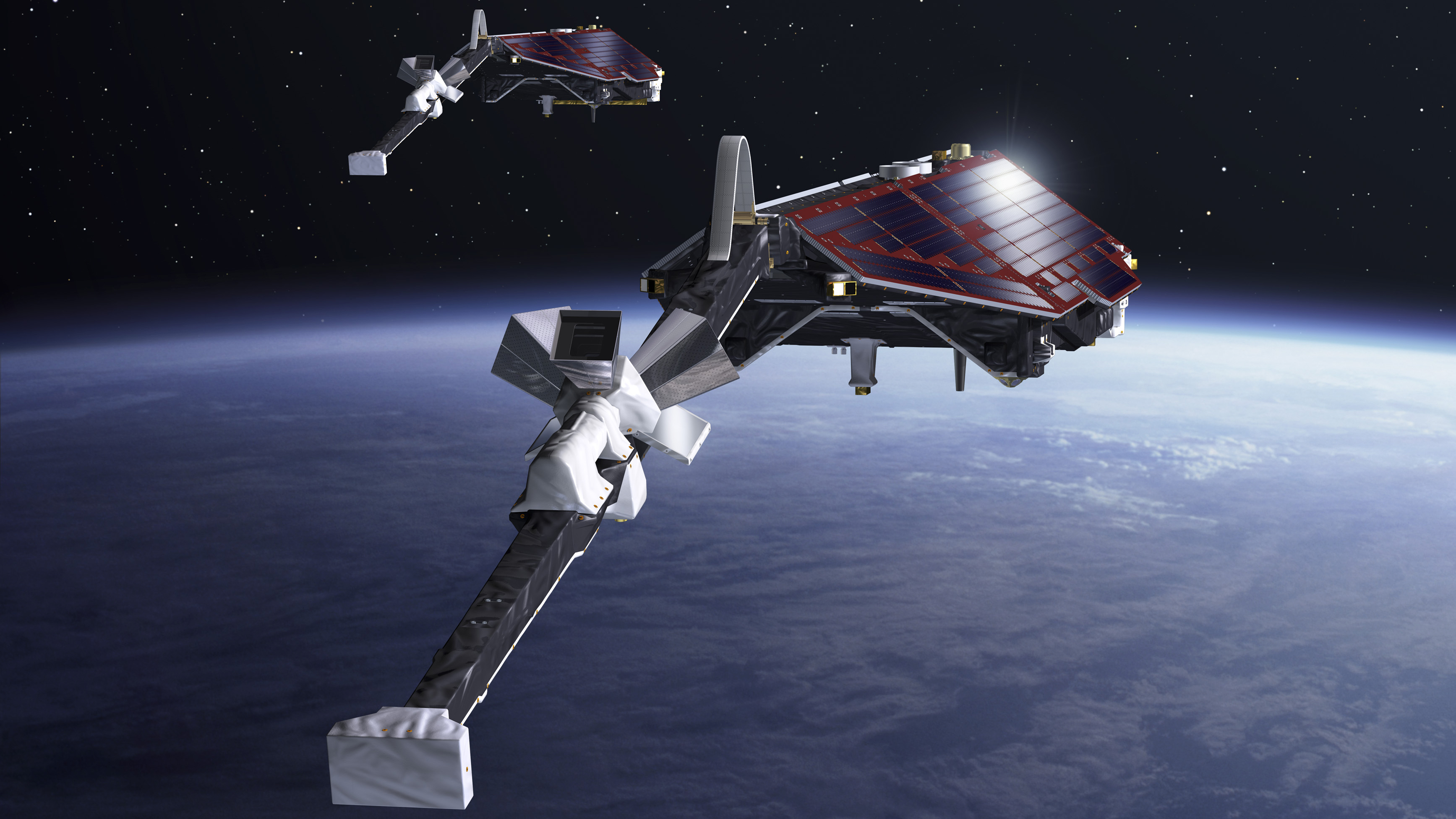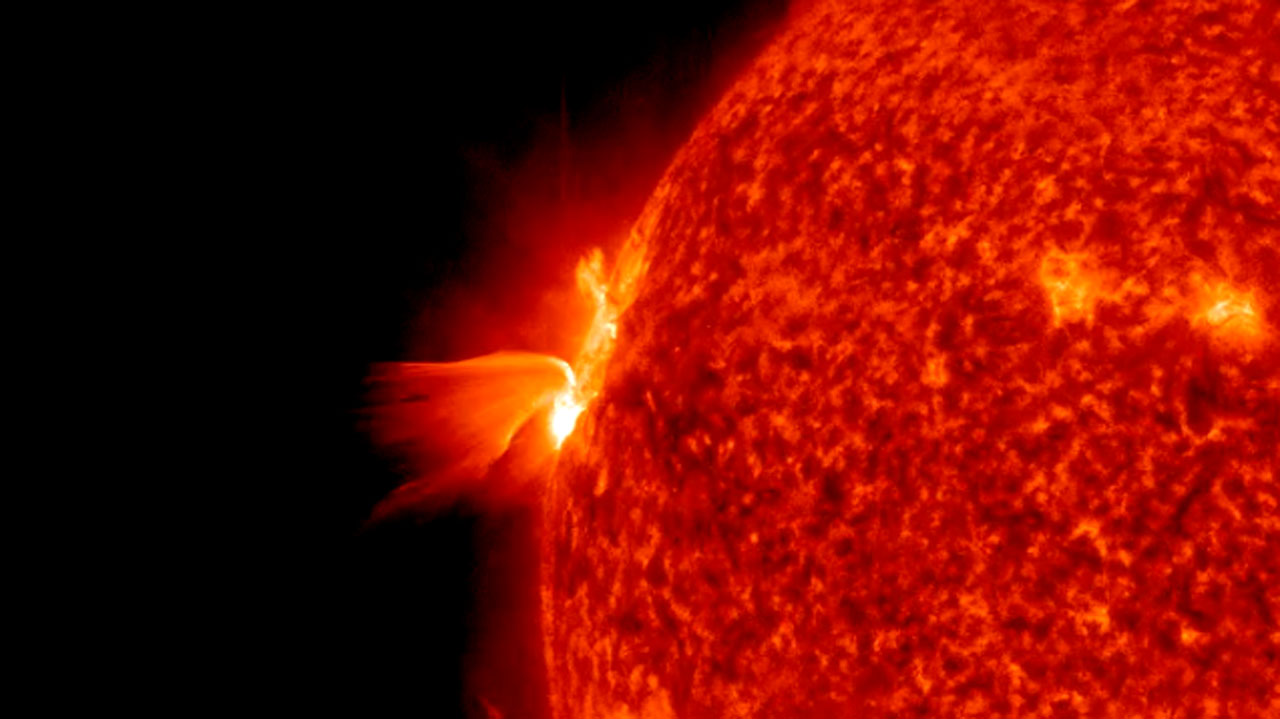Wild solar weather is causing satellites to plummet from orbit. It's only going to get worse.
The change coincided with the onset of the new solar cycle, and experts think it might be the beginning of some difficult years.

In late 2021, operators of the European Space Agency's (ESA) Swarm constellation noticed something worrying: The satellites, which measure the magnetic field around Earth, started sinking toward the atmosphere at an unusually fast rate — up to 10 times faster than before. The change coincided with the onset of the new solar cycle, and experts think it might be the beginning of some difficult years for spacecraft orbiting our planet.
"In the last five, six years, the satellites were sinking about two and a half kilometers [1.5 miles] a year," Anja Stromme, ESA's Swarm mission manager, told Space.com. "But since December last year, they have been virtually diving. The sink rate between December and April has been 20 kilometers [12 miles] per year."
Satellites orbiting close to Earth always face the drag of the residual atmosphere, which gradually slows the spacecraft and eventually makes them fall back to the planet. (They usually don't survive this so-called re-entry and burn up in the atmosphere.) This atmospheric drag forces the International Space Station's controllers to perform regular "reboost" maneuvers to maintain the station's orbit of 250 miles (400 km) above Earth.
This drag also helps clean up the near-Earth environment from space junk. Scientists know that the intensity of this drag depends on solar activity — the amount of solar wind spewed by the sun, which varies depending on the 11-year solar cycle. The last cycle, which officially ended in December 2019, was rather sleepy, with a below-average number of monthly sunspots and a prolonged minimum of barely any activity. But since last fall, the star has been waking up, spewing more and more solar wind and generating sunspots, solar flares and coronal mass ejections at a growing rate. And the Earth's upper atmosphere has felt the effects.
Related: The biggest spacecraft ever to fall uncontrolled from space
"There is a lot of complex physics that we still don't fully understand going on in the upper layers of the atmosphere where it interacts with the solar wind," Stromme said. "We know that this interaction causes an upwelling of the atmosphere. That means that the denser air shifts upwards to higher altitudes."
Denser air means higher drag for the satellites. Even though this density is still incredibly low 250 miles above Earth, the increase caused by the upwelling atmosphere is enough to virtually send some of the low-orbiting satellites plummeting.
Get the Space.com Newsletter
Breaking space news, the latest updates on rocket launches, skywatching events and more!
"It's almost like running with the wind against you," Stromme said. "It's harder, it's drag — so it slows the satellites down, and when they slow down, they sink."
Knocked down by a solar storm
The Swarm constellation, launched in 2013, consists of three satellites, two of which orbit Earth at an altitude of 270 miles (430 km), about 20 miles (30 km) above the International Space Station. The third Swarm satellite circles the planet somewhat higher — about 320 miles (515 km) above ground. The two lower-orbiting spacecraft were hit more by the sun's acting out than the higher satellite was, Stromme said.
The situation with the lower two got so precarious that by May, operators had to start raising the satellites' altitude using onboard propulsion to save them.
ESA's Swarm satellites are not the only spacecraft struggling with worsening space weather. In February, SpaceX lost 40 brand-new Starlink satellites that were hit by a solar storm just after launch.
Related: Fiery death of SpaceX Starlink satellites captured on video after geomagnetic storm

In such storms, satellites suddenly drop to lower altitudes. The lower the orbit of the satellites when the solar storm hits, the higher the risk of the spacecraft not being able to recover, leaving operators helplessly watching as the craft fall to their demise in the atmosphere.
Starlink satellites have operational orbits of 340 miles (550 km), which is above the most at risk region. However, after launch, Falcon 9 rockets deposit the satellite batches very low, only about 217 miles (350 km) above Earth. SpaceX then raises the satellites' orbits using onboard propulsion units. The company says that approach has advantages, as any satellite that experiences technical problems after launch would quickly fall back to Earth and not turn into pesky space debris. However, the increasing and unpredictable behavior of the sun makes those satellites vulnerable to mishaps.
New space and the unpredictable sun
All spacecraft around the 250-mile altitude are bound to have problems, Stromme said. That includes the International Space Station, which will have to perform more frequent reboost maneuvers to keep afloat, but also the hundreds of cubesats and small satellites that have populated low Earth orbit in the past decade. Those satellites — a product of the new space movement spearheaded by private entrepreneurs pioneering simple, cheap technologies — are particularly vulnerable.
"Many of these [new satellites] don't have propulsion systems," Stromme said. "They don't have ways to get up. That basically means that they will have a shorter lifetime in orbit. They will reenter sooner than they would during the solar minimum."
By coincidence (or beginner's luck), the onset of the new space revolution came during that sleepy solar cycle. These new operators are now facing their first solar maximum. But not only that. The sun's activity in the past year turned out to be much more intense than solar weather forecasters predicted, with more sunspots, more coronal mass ejections and more solar wind hitting our planet.
"The solar activity is a lot higher than the official forecast suggested," Hugh Lewis, a professor of engineering and physical sciences at the University of Southampton in the U.K. who studies the behavior of satellites in low Earth orbit, told Space.com. "In fact, the current activity is already quite close to the peak level that was forecasted for this solar cycle, and we are still two to three years away from the solar maximum."
Stromme confirmed those observations. "The solar cycle 25 that we are entering now is currently increasing very steeply," she said. "We do not know if this means that it will be a very tough solar cycle. It could slow down, and it could become a very weak solar cycle. But right now, it's increasing fast."
Cleaning up orbits
While the harsh solar activity is bad news for satellite operators, who will see the lifetimes of their missions shortened (even satellites with onboard propulsion will run out of fuel much faster because of the need for frequent altitude boosts), the situation will have some welcome purifying effects on the space around Earth.
In addition to becoming populated with hundreds of new satellites over the past decade, this region of space is cluttered with a worrying amount of space debris (old satellites, spent rocket stages and collision fragments). Researchers like Lewis have long warned that the omnipresent junk hurtling around the planet threatens the safety of satellite services, forcing operators to conduct frequent avoidance maneuvers. Moreover, the debris might trigger an out-of-control situation known as Kessler syndrome, an unstoppable cascade of collisions as depicted in the 2013 Oscar-winning movie "Gravity."
"Generally speaking, increasing solar activity — and its effect on the upper atmosphere — is good news from a space debris perspective, as it reduces orbital lifetimes of the debris and provides a useful 'cleaning service,'" Lewis said.
According to Jonathan McDowell, a space debris expert at the Harvard-Smithsonian Center for Astrophysics, the positive effect can already be observed, as fragments produced by the November 2021 Russian anti-satellite missile test are now coming down much faster than before.
However, there is a downside to this cleansing process.
"The increased rate of decay of debris objects can be perceived almost like rain," Lewis said. "When solar activity is high, the 'rain' rate is higher, and missions at lower altitudes will potentially experience a greater flux of debris."
A greater flux of debris means the need for even more frequent fuel-burning avoidance maneuvers and a temporarily increased risk of collisions, which could potentially generate more dangerous fragments.
Stromme and her colleagues are currently raising the orbit of the two low-orbiting Swarm satellites by 28 miles (45 km). The satellites might require even more adjustments later this year, she added. The goal is to help the mission, which is currently in its ninth year and beyond its originally planned lifetime, to get through the solar cycle. Whether the team succeeds will largely depend on the behavior of the sun.
"We still have fuel to get us hopefully through another solar cycle," Stromme said. "If it grows like now, I will use up the fuel before the solar cycle is finished. If it slows down a little, I might save them through the solar cycle."
Follow Tereza Pultarova on Twitter @TerezaPultarova. Follow us on Twitter @Spacedotcom and on Facebook.
Join our Space Forums to keep talking space on the latest missions, night sky and more! And if you have a news tip, correction or comment, let us know at: community@space.com.

Tereza is a London-based science and technology journalist, aspiring fiction writer and amateur gymnast. Originally from Prague, the Czech Republic, she spent the first seven years of her career working as a reporter, script-writer and presenter for various TV programmes of the Czech Public Service Television. She later took a career break to pursue further education and added a Master's in Science from the International Space University, France, to her Bachelor's in Journalism and Master's in Cultural Anthropology from Prague's Charles University. She worked as a reporter at the Engineering and Technology magazine, freelanced for a range of publications including Live Science, Space.com, Professional Engineering, Via Satellite and Space News and served as a maternity cover science editor at the European Space Agency.









